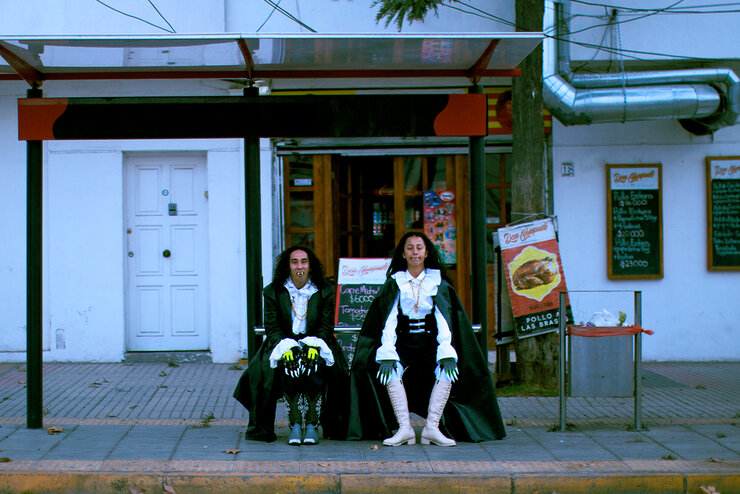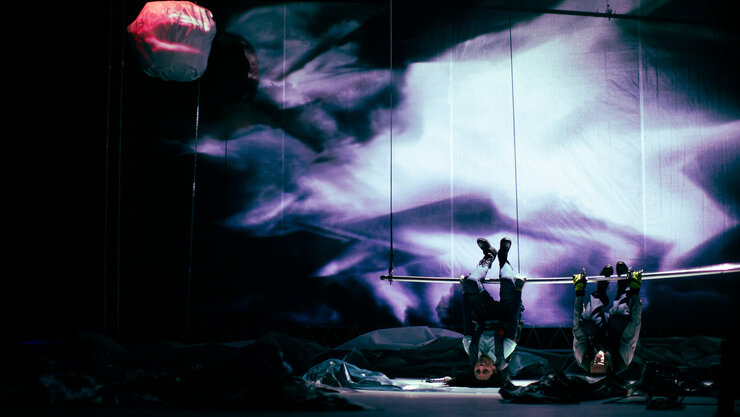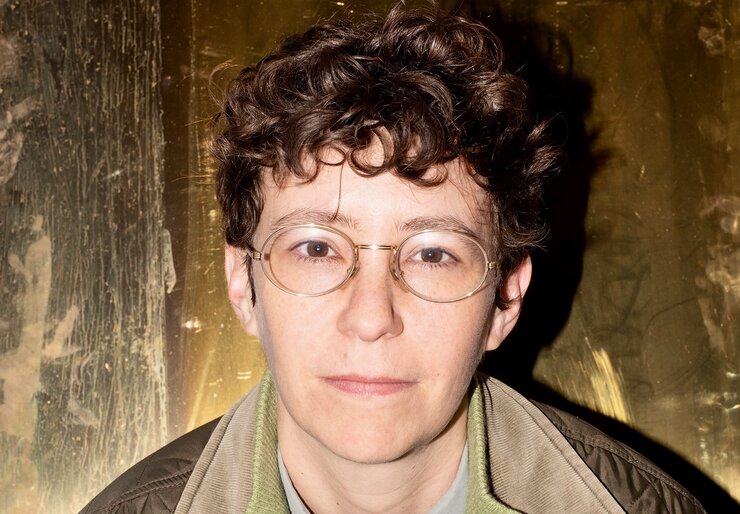A Zoom talk with Manuela Infante and Lea Loeb (Zürcher Theater Spektakel)
Chilean theatre-maker Manuela Infante is one of the most influential voices in contemporary Latin American theatre. With political precision, poetic force, and subversive humour, she challenges dominant ideas about humans, nature, and power – while also exploring new forms of physicality on stage. On the occasion of presenting her new piece «Vampyr» at the Zürcher Theater Spektakel, she spoke with curator Lea Loeb about postcolonial takes on renewable energy, the vampire as a figure of resistance, about humour and exhaustion – and why theatre should be a space for
Hello Manuela, thanks so much for taking the time for this interview. In August, you’ll be presenting your new piece «Vampyr» at the Zürcher Theater Spektakel. The production works on many levels. At first glance, we see two vampires on stage – funny, endearing characters. But it also digs into deeper issues like exploitation in the capitalist labour market, neo-colonial power structures, and more. It’s not the first time that vampires have appeared in your work. What draws you to this figure? And more specifically: what interests you about the Latin American vampire?
What has always fascinated me about the vampire myth is its hybrid nature – how it slips through fixed categories. It’s neither alive nor dead, neither animal nor human – and at the same time, it’s decaying, so in a sense, it’s also part of the earth. I’m drawn to this in-between state, and I’ve explored it in several of my works. The vampire is a widespread mythological figure, but what really interests me is its resistance to categorisation: human/non-human, nature/culture, civilised/wild. It refuses the fiction of the human as something separate from the rest of the world – a story invented by European modernity.
For a long time, I’ve been working to question and dismantle the colonial idea of what it means to be «human». The vampire gives me a way to speak from a Global South perspective. Colonialism destroyed entangled cosmologies in which the human and the non-human weren’t seen as separate. But these ways of thinking have survived. I see theatre as a pllace for that resistance, where such imposed categories can be challenged. So inventing a «vampiro sudaka» – a Latin American vampire – becomes an act of disobedience. It’s not some posh European Dracula, sitting in his library. Our vampire is a wild, hybrid creature that breaks apart colonial notions of identity.
Donna Haraway argues that, to exploit the other, you first have to symbolically kill it – by cutting yourself off from it, turning it into something external. «I’m human, that’s animal»; «I’m culture, that’s nature». Those separations are what make exploitation possible in the first place. That’s why we need to question such categories – they were created to justify colonial appropriation.
There’s growing fascination with the non-human – especially in artistic and academic circles in the Global North. But what’s often overlooked is that the very lines we now try to blur were once drawn to enable colonial practices. If we understand colonialism as the appropriation and exploitation of an Other, then we can recognize that it is dependent on these separations: human from non-human, nature from culture. That’s why the «sudaka» vampire is more than a poetic image. It is an act of resistance, a way of disobeying thatinherited colonial logic – a logic that still runs deep in how we see, think, and act today.
In some of your previous work, you’ve explored the privatisation and exploitation of natural resources – a harsh reality in many parts of the Global South. In Chile, this issue is particularly urgent, with European and North American corporations extracting rare earths and metals in deeply destructive ways. In «Vampyr», you shift the focus to the exploitation of human resources – in other words, labour. How do you see these different forms of exploitation as connected?
For me, it’s not a shift in perspective – it’s a continuation. It’s not just about talking specifically about the exploitation of human resources, but about understanding that all forms of life are deeply entangled. There are no human bodies that exist independently from other bodies. Life is intertwined, symbiotic. And when you try to «kill» the other conceptuallyin order to exploit them, you cut right through that vital web. That’s why these categories fail once and again – because they don’t reflect reality.
I question the conceptual and linguistic separation between the exploitation of human resources and that of nature. The vampires in my piece resist such categories – what makes them so compelling is that they embody entangled forms of existence.
We’ve seen this with Covid, or with microplastics that accumulate in living organisms. We are deeply interdependent. And to me, the vulnerability that comes from being tied into to others is something deeply valuable.
In Chile, we often use the term «zonas de sacrificio» – sacrifice zones – to describe areas that have been devastated by exploitation. I find this expression very telling, because it points to the fact that certain lives and territories are treated as expendable in the name of economic development. My work tries to show that these sacrifice zones are inhabited – by dense constellations of life, death, and exploitation.
In that sense, the vampire is the perfect figure: a creature made up of many parts, embodying ambiguity and a kind of undefined existence. As it’s put in the piece: «part dead, part alive, part human, part animal, part earth.»

In this piece, wind energy takes centre stage. At first glance, the shift to renewables might seem like a path to emancipation – a cleaner, supposedly less destructive alternative. But is that really so? Could so-called sustainable energy sources also be part of a new wave of neocolonial extractivism?
I find the concept of sustainability deeply problematic. Even the term itself contains a trap: «to sustain» – but to sustain what exactly? All too often, it’s about sustaining -perpetuating- the same system that depletes both human and non-human resources. It feels more like a technological shift in the mechanisms of exploitation – and sometimes, simply a shift in who gets to exploit whom.
During rehearsals, we often talked about exhaustion – not just in terms of energy, but in a deeper, existential sense. What does it mean to feel exhausted? What is energy? How does it circulate? Energy is not just a resource to be extracted – it’s something that connects beings, that entangles forms of life to each other. And it deserves a way of existing that goes beyond mere utility.
There’s a line in the piece that says: «The wind is no longer allowed to play, to lift skirts or blow away hats.» It is now condemned to be efficient. I’m interested in this dimension of energy spending that doesn’t produce anything, doesn’t serve a purpose – but that simply enjoys itself. Today’s notion of sustainability is built on an understanding of energy that is too narrow. It also leans on a dangerous belief: that humans broke the planet and now must fix it. That only reinforces the illusion of human supremacy. We live in a logic of compensation – just look at emissions trading. What an arrogant idea: that we could somehow balance energy and resources, as if the planet’s equilibrium were ours to manage.…
Yet this greater equilibrium remains profoundly alien and mysterious to us. We are entangled in a vast ecological web – and yet we perceive only the tiniest fragment of it. We need to let go of the paradigm of compensation and open ourselves to an acknowledgment of vulnerability.
Stones have appeared as central figures in several of your works. I’m curious: how do you relate to the inanimate – the «dead»? What draws you to the stone, especially as a theatre maker working with bodies and language?
To me, life includes the non-living. After all, what better way to describe life than through death? Life is precisely that which can die. The distinction between the living and the non-living also serves a purpose in systems of exploitation: if I claim something isn’t alive, I can use or destroy it without hesitation. But death is part of life. There’s a line in the piece that goes: «What could strip life of its joy more than the prospect of it never ending?»
The problem is that we live fantasizing with the idea of finding a "spending" with no collateral cost. – a classic narrative of progress, even of so-called green progress. To restore value to what we call dead allows us to acknowledge that everything we spend, consume, exploit has a cost, there is no escaping that. All life involves decay. And I believe that awareness is fundamental.
One striking aspect of the piece is the physicality of the two performers. How do you work with them? How do you develop this distinctive physical language and movement aesthetic?
Rehearsals were a kind of collective exploration of the indeterminate, and they began even before the text emerged. I wanted to find out how, through performativity and physical work, we could subvert the idea of fixed beings – of individuals as coherent, self-contained, clearly defined subjects.
How can we question this rigid, monocultural idea that you have to be identical with yourself? In theatre, there’s often this assumption that a character needs to be consistent – to have a clear, stable identity. But in this project, I’m exploring the opposite: beings that resist coherence, that are permeable, open, porous. Together with the performers, we explored how this state can be embodied on stage.
We’ve been working with a concept by Peruvian anthropologist Marisol de la Cadena that I really like – the idea of the «not only». The notion that everything is what it is – and not only that. She calls it a «negative lever»: when we say a cup is a cup – and not only – we open up a space where the fixing of that identity can be interrupted. I’m interested in how fragility can be embodied: that sensation of drifting, of being entangled in something you can’t control.
This is exactly what we explored in rehearsals: How do you embody an animal – and not only? What does it mean to be human – and not only? The physicality that emerges is the result of constantly shifting, expanding, slipping beyond what is being represented in the moment. When we work on the physicality of an animal, there is also – subtly – the presence of an elderly person. But not only. A dead body resonates in the movement too. The performers continuously play with these layers, resisting any clear-cut or fixed reading of what they represent.
This creates a body that is constantly shifting – vibrating, indeterminate, never fully fixed. The two performers put themselves in a highly exposed position, because the work they do on stage is neither comfortable nor familiar. It’s deeply performative: it happens in the here and now of each performance. Together, we developed specific techniques to keep this movement alive in the body – this active resistance to any closed or final definition.

The piece is extraordinarily funny. What role does humour play in your work?
For me, humour is not just a surface layer you add to a subject. I often get the sense that people see it that way – as a tool to make difficult or complex topics more digestible. But in my case, humour is at the very core of my work. It’s where political critique lives. And I think that’s something very Chilean. This particular brand of dark, cynical humour feels like a true cultural asset of our country.
Just think of Raúl Ruiz’s films or many contemporary Chilean comedians. There’s something there – maybe even something broadly South American – that brings together a deep awareness of horror with an equally deep love for life. And out of that mix emerges a kind of humour that’s both dark and vital. A strong desire to live, paired with sharp critique.
I think what I'm trying to say is that this humour is perhaps the most Chilean aspect of our work – the part most deeply rooted in our cultural context. And sometimes, it’s precisely this humour that confuses audiences outside of Chile. Because it comes from a very specific lived reality. It’s a humour of survival, a humour that speaks from the wound – but with a strong urge to live, with the will to keep going. During rehearsals, humour becomes a kind of compass: if we laugh, we know we’re heading in the right direction.
And finally: What can the audience in Zurich expect from «Vampyr»?
The audience will be confronted with a kind of questioning – a crisis of things we often take for granted. For example, the supposed cleanliness and positivity of so-called green energy. There’s a text by Rosi Braidotti that I really appreciate. In it, she argues that the climate crisis has triggered a «re-homogenisation» of the collective «we» of humanity.
But, it’s crucial to acknowledge that this collective «we», often invoked in the context of crisis, is anything but homogeneous. One of my favourite lines by Braidotti is: «We are all in this together – but we’re not the same.» That’s exactly what we’re bringing to the stage: a perspective that critically questions the supposed universality of this «we» – especially when it comes to energy. As I said, the piece is full of entanglements. And that’s entirely intentional: I’m not interested in unravelling anything. I want to entangle. Because in this state of entanglement, our vulnerability as a species becomes visible – bodies bound to other bodies, fragility and vulnerability.
«Vampyr» invites us to question things we often take for granted – such as the idea of «clean» energy. It highlights how our historical, material, and geographical conditions shape the ways in which we experience crisis. I’m really looking forward to bringing this piece to Switzerland. I’ve already worked with the ensemble at Theater Basel, but this time I’ll be travelling with my own team – and with a work that is deeply, unmistakably Chilean.
Thank you for your time and this thought-provoking conversation. We’re very much looking forward to welcoming you to Zurich this August.
Credits
Interview: Lea Loeb
The conversation took place in Spanish.
German translation: Lea Loeb
English translation: Franziska Henner
Portrait photo: Manuela Infante
Photos from «Vampyr»: Franco Barrios
